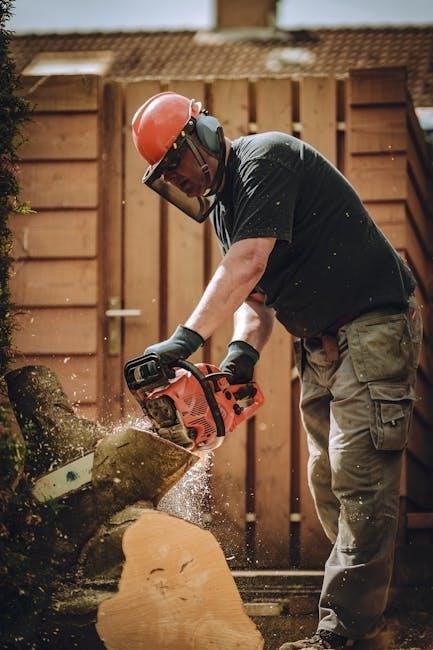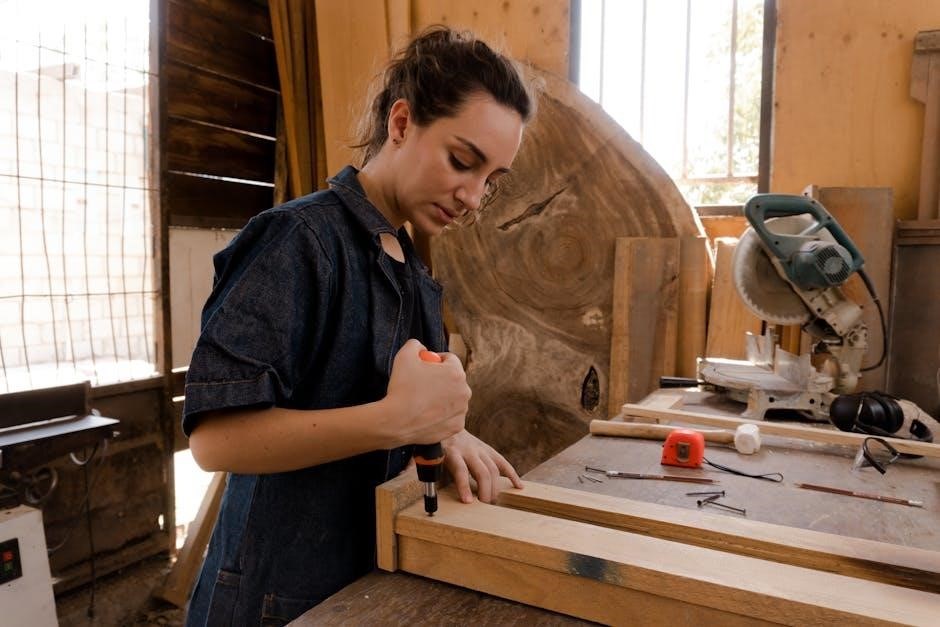The jig saw manual provides essential information on using the tool safely and effectively, including proper handling and maintenance, with clear instructions and guidelines for optimal performance and operator safety always.
Importance of Safety Precautions
The importance of safety precautions when using a jig saw cannot be overstated, as it is a powerful tool that can cause serious injury if not handled properly. According to the manual, users should always wear protective eyewear, hearing protection, and cut-resistant work gloves while operating the saw. This is because the saw can produce high-speed debris and loud noises that can damage hearing and vision. Additionally, the manual emphasizes the importance of keeping loose clothing and long hair tied back, as these can get caught in the saw and cause accidents. By following these safety precautions, users can minimize the risk of injury and ensure a safe and successful operation. The manual also provides guidelines for proper handling and maintenance of the saw, including regular cleaning and inspection of the blade and other parts. This helps to prevent accidents and ensures that the saw continues to function properly. Overall, safety precautions are a crucial aspect of using a jig saw, and users should always follow the guidelines outlined in the manual.

Operating the Jig Saw
Start the jig saw by pulling the trigger, allowing it to reach full speed before moving, with caution and careful handling always;
Resting the Saw Shoe
The saw shoe is an essential component of the jig saw, and resting it properly is crucial for safe and effective operation. To rest the saw shoe, place it on the edge of the material, near the cutting line, with the blade next to but not touching the material. This position allows for precise control and helps prevent accidents. The saw shoe should be rested gently, without applying too much pressure, to avoid damaging the material or the saw. By following this simple step, users can ensure a smooth and safe cutting experience. The internet provides various resources and guidelines on how to properly rest the saw shoe, including tutorials and instructional videos. Additionally, the jig saw manual provides detailed instructions on the proper use and maintenance of the saw shoe, emphasizing the importance of resting it correctly. Proper resting of the saw shoe is essential for optimal performance and safety.

Jig Saw Design and Features
The jig saw has a unique design with various features, including a comfortable grip and ergonomic handle, making it easy to use and maneuver, with a focus on user comfort and safety always.
Orbital Jig Saw Design
The orbital jig saw design provides for easy handling and maneuverability, with a focus on comfort and control. This design allows for smooth and precise cutting, making it ideal for various applications. The orbital motion of the saw blade enables efficient cutting of different materials, including wood and metal. The design of the orbital jig saw also features a compact and lightweight body, making it easy to use and transport. Additionally, the ergonomic handle and grip provide a comfortable hold, reducing fatigue and strain during extended use. The orbital jig saw design is also equipped with a variety of features, such as adjustable speed and orbital settings, allowing for customization to suit specific cutting tasks. With its advanced design and features, the orbital jig saw is a versatile and reliable tool for various cutting applications, providing accurate and efficient results. The design is well-suited for both professional and DIY use.

Jig Saw Maintenance and Care
Regular cleaning and inspection of the jig saw is necessary for optimal performance and longevity always ensured with proper handling.
Proper Care and Maintenance
To ensure the longevity and optimal performance of the jig saw, proper care and maintenance are essential. This includes regular cleaning of the saw and its components, such as the blade and shoe. The saw should be stored in a dry place, away from direct sunlight and moisture. It is also important to check the saw’s cord and plug for any damage or wear, and to replace them if necessary. Additionally, the saw’s blades should be regularly inspected and replaced when worn or damaged. By following these simple maintenance tips, users can help extend the life of their jig saw and ensure it continues to operate safely and effectively. Regular maintenance can also help prevent accidents and injuries, and ensure the saw remains in good working condition. The user manual provides more detailed information on maintenance and care, and should be consulted regularly for guidance and advice.

Jig Saw Blades and Accessories
Jig saw blades and accessories are designed for specific tasks, with various types available for different materials and applications always.
Blade Types and Removal
The jig saw manual explains the different types of blades available, including T-shank and U-shank blades, and provides instructions on how to remove and replace them. The process of removing the blade involves holding the rapid change blade clamp up and pulling out the saw blade. It is essential to note that the jig saw is designed to use specific types of blades, and using the wrong type can lead to poor performance or damage to the tool. The manual also provides guidance on how to handle the blades safely and avoid accidents. Additionally, the manual explains how to properly store the blades when not in use to prevent damage or loss. By following the instructions in the manual, users can ensure that they are using the correct blades and removing them safely and efficiently. The manual’s instructions on blade removal are clear and easy to follow, making it a valuable resource for users.
